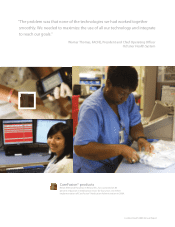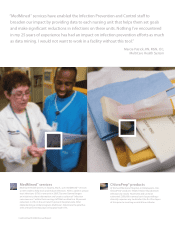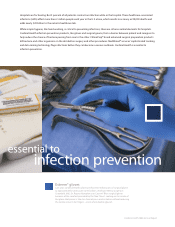Cardinal Health 2008 Annual Report Download - page 18
Download and view the complete annual report
Please find page 18 of the 2008 Cardinal Health annual report below. You can navigate through the pages in the report by either clicking on the pages listed below, or by using the keyword search tool below to find specific information within the annual report.Cardinal Health 2008 Annual Report
essential
responsibilities
Customers
Cardinal Health awarded $1 million in grants to support new
and innovative programs that enhance patient safety and
quality of care at 34 hospitals, health systems and community
health clinics across the country. The patient safety grants
program is the largest and first of its kind and attracted
applications from more than 700 hospitals. The Cardinal Health
Foundation has also provided more than $11 million for
essential healthcare initiatives since its inception in 2002.
Shareholders
Cardinal Health core values are a driving force for
employees, but provide essential benefits to shareholders.
The five principles of Ethical, People-driven, Performance-
driven, Innovative and Collaborative (EPPIC) guide our
employees to the “right” way of doing business. In addition,
the company’s corporate governance has been strengthened
in recent years through annual election of directors, limiting
directorships for board members, a majority voting provision,
annual ratification of the company’s external auditor and a
formalized employee code of conduct.
Employees
Cardinal Health is committed to the health and safety of its
employees. The company has implemented competitive
health and wellness programs aimed at reducing work-
related injuries and lost time, a career roadmap system to
help employees at all levels understand and plan their career
development within the company, and diversity and inclusion
programs with Diversity Councils in each operating segment.
In addition, Cardinal Health launched the EveryOne Matters
campaign, which encourages managers and co-workers to
improve employee engagement and career satisfaction by
instilling that recognition and appreciation are an essential
piece of the Cardinal Health culture.
Communities
Fostering strong relationships with the communities where
our employees live and work is an essential responsibility
for Cardinal Health. In 2007, the Cardinal Health Foundation
contributed more than $7 million to non-pro t initiatives
that improve healthcare, create and support healthy
communities, and encourage employee volunteerism.
In addition, employees raised a company-record-setting
$2 million as part of the company’s annual giving campaign.
Cardinal Health also contributed more than $7.8 million
in funds and product donations to humanitarian relief
efforts for disasters such as the California wildfires, the
Myanmar and Midwestern U.S. oods, and the earthquake
in Chengdu, China.
Environment
Cardinal Health is nding essential ways to lessen its
environmental footprint. By redesigning the packaging of
surgical kits, the company has saved 3 million pounds of
packaging material over a five-year period. Hospitals that
use single-use surgical draping and gowning systems, like
Cardinal Health Convertors® products, can reduce their CO2
emissions by nearly 23 tons and reduce water usage by
nearly 700,000 gallons annually by eliminating the need to
wash surgical drapes and gowns. Additionally, the company’s
West Campus headquarters expansion in Dublin, Ohio, is
pursuing Leadership in Energy and Environmental Design
(LEED) certi cation by the U.S. Green Building Council. A
few examples of the environmental benefits include highly
e icient HVAC systems, an abundance of natural light for
employees and sourcing materials close to the construction
site to reduce fuel costs for transportation.
























